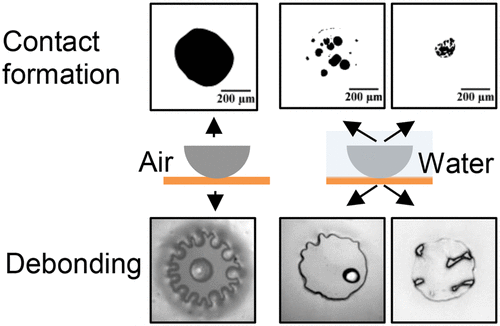当前位置:
X-MOL 学术
›
ACS Appl. Mater. Interfaces
›
论文详情
Our official English website, www.x-mol.net, welcomes your feedback! (Note: you will need to create a separate account there.)
Importance of Substrate Functionality on the Adhesion and Debonding of a Pressure-Sensitive Adhesive under Water
ACS Applied Materials & Interfaces ( IF 9.5 ) Pub Date : 2017-11-22 00:00:00 , DOI: 10.1021/acsami.7b13984 Preetika Karnal , Paul Roberts , Stefan Gryska 1 , Courtney King , Carlos Barrios 1 , Joelle Frechette
ACS Applied Materials & Interfaces ( IF 9.5 ) Pub Date : 2017-11-22 00:00:00 , DOI: 10.1021/acsami.7b13984 Preetika Karnal , Paul Roberts , Stefan Gryska 1 , Courtney King , Carlos Barrios 1 , Joelle Frechette
Affiliation

|
We investigate the effect of an aqueous environment on the adhesion of a model acrylic pressure-sensitive adhesive (PSA) composed of 2-ethylhexyl acrylate-co-acrylic acid. We use probe-tack adhesion measurements accompanied by in situ imaging of the contact region during bonding and debonding. Within the probe-tack tests, we use both hydrophilic (piranha and plasma treatment) and hydrophobic (C18-silanization) surface treatments to investigate the contribution of the probe’s surface energy on the underwater adhesion. In examining contact formation in air and underwater, we find that the presence of water when contact is made leads to different modes of PSA relaxation and contact formation. For all probes investigated, the adhesive strength between the PSA and the probe decreases when measured underwater. Additionally, we observe that the presence of water during debonding has a more pronounced effect on the adhesive strength of the PSA when probed by a hydrophilic surface as opposed to a hydrophobic surface. Using fingering wavelength analysis, we estimate the surface energy of the PSA in situ and find that when submerged in water, the PSA has a significantly higher surface energy compared to in air. Therefore, combining the observation of different modes of contact formation, the increase in surface energy, and the importance of the surface energy of the probe, we suggest that the decrease in adhesive strength in water can be explained by the hydration of the PSA and by trapped water defects between the PSA and the probe.
中文翻译:

底物功能对水下压敏胶粘剂的粘合和剥离的重要性
我们研究了水性环境对由丙烯酸2-乙基己酯-共-丙烯酸组成的模型丙烯酸压敏胶粘剂(PSA)的粘附力的影响。我们在结合和脱胶过程中使用探针粘性附着力测量以及接触区域的原位成像。在探钉测试中,我们同时使用亲水性(食人鱼和血浆处理)和疏水性(C 18-硅烷化)表面处理,以研究探针的表面能对水下附着的影响。在检查空气和水下的接触形成时,我们发现进行接触时水的存在会导致PSA松弛和接触形成的不同模式。对于所有调查的探头,在水下测量时,PSA和探头之间的粘合强度会降低。另外,我们观察到,当通过亲水性表面而不是疏水性表面探测时,在脱胶过程中水的存在对PSA的粘合强度具有更明显的影响。使用指状波长分析,我们就地估算了PSA的表面能,发现与水相比,浸入水中时,PSA的表面能明显更高。所以,
更新日期:2017-11-22
中文翻译:

底物功能对水下压敏胶粘剂的粘合和剥离的重要性
我们研究了水性环境对由丙烯酸2-乙基己酯-共-丙烯酸组成的模型丙烯酸压敏胶粘剂(PSA)的粘附力的影响。我们在结合和脱胶过程中使用探针粘性附着力测量以及接触区域的原位成像。在探钉测试中,我们同时使用亲水性(食人鱼和血浆处理)和疏水性(C 18-硅烷化)表面处理,以研究探针的表面能对水下附着的影响。在检查空气和水下的接触形成时,我们发现进行接触时水的存在会导致PSA松弛和接触形成的不同模式。对于所有调查的探头,在水下测量时,PSA和探头之间的粘合强度会降低。另外,我们观察到,当通过亲水性表面而不是疏水性表面探测时,在脱胶过程中水的存在对PSA的粘合强度具有更明显的影响。使用指状波长分析,我们就地估算了PSA的表面能,发现与水相比,浸入水中时,PSA的表面能明显更高。所以,

























 京公网安备 11010802027423号
京公网安备 11010802027423号